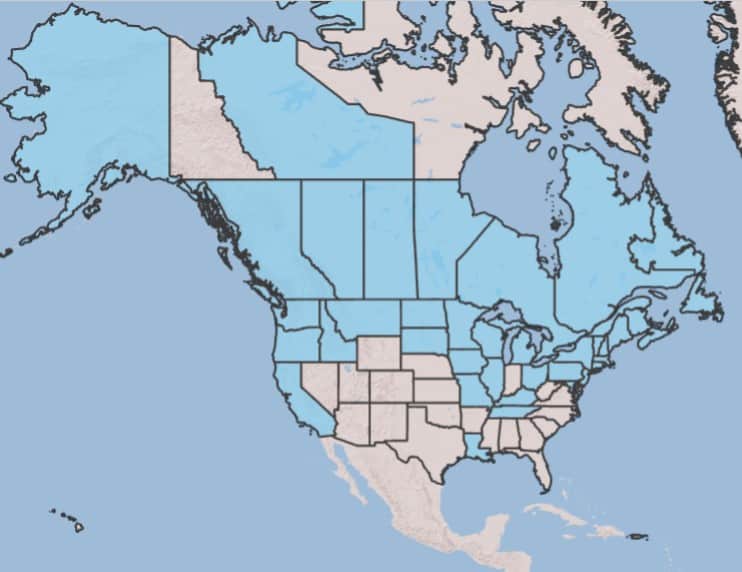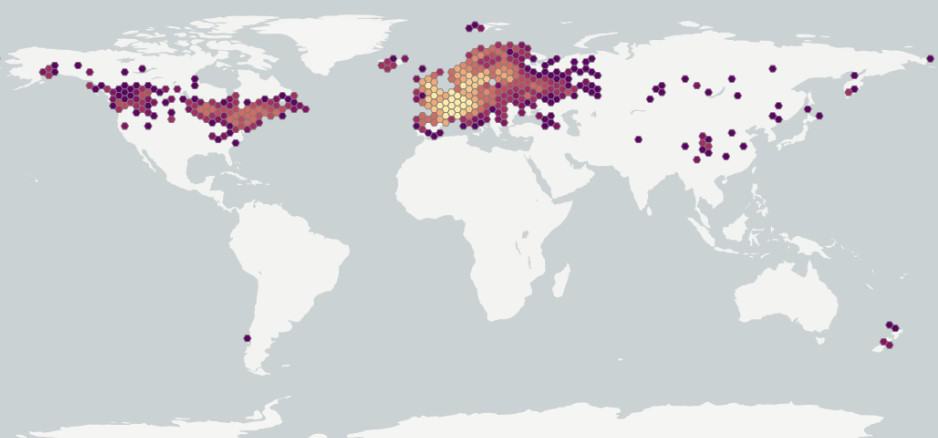Galeopsis tetrahit
Explore More :
Explore plus :
Overview
Aperçu
Regulation :
Remarques Réglementation:
- Quarantine lists of countries e.g. Mexico *may be updated without notice
- USA Federal Noxious Weed Seed List
Regulation Notes:
Distribution :
Répartition :
This species is native to Europe and temperate Asia and was introduced in North America (O’Donovan and Sharma 1987; USDA-ARS 2022). The species is widespread in the northern United States (USDA-NRCS 2017). It occurs across Canada except for Nunavut and the Yukon (Brouillet et al. 2010+) and is frequent throughout British Columbia (Klinkenberg 2023).
Habitat and Crop Association :
Habitat et Cultures Associées :
Galeopsis tetrahit grows in cultivated fields, pastures, swamps, thickets, forests, ditches, roadsides, and disturbed areas (Darbyshire 2003). It favours moist, mesic, nutrient-rich soils. Low soil moisture may be a limiting factor in its distribution and spread (O’Donovan and Sharma 1987). This species can be problematic in field crops such as Avena sativa (oats), Medicago sativa (alfalfa), Solanum tuberosum (potato) and Glycine max (soybean) (Légère and Deschênes 1989; 1991). It was noted that the species can form dense stands in grain fields and seeded pastures in Ontario, Canada (Alex 2011).
Economic Use, cultivation area, and Weed Association :
Utilisation économique, zone de culture et association de mauvaises herbes :
Duration of Life Cycle :
Durée du cycle vital:
Annual
Dispersal Unit Type :
Type d’unité de dispersion :
Nutlet
General Information
RENSEIGNEMENTS GÉNÉRAUX
Galeopsis tetrahit is an agricultural weed known to reduce yields of several crops and to be a reservoir for several plant pathogens (e.g., Phoma exigua) and nematodes (e.g., Ditylenchus dipsaci; Heterodera spp.). Each plant produces an average of 387 nutlets, dispersed by wind, water, farm machinery, and contaminated crop seed (O’Donovan and Sharma 1987). The nutlets have a strong dormancy (O’Donovan and Sharma 1987) and could remain viable for a few years (Conn and Werdin-Pfisterer, 2010).
The taxonomy has been debated for a number of years and authors recognize Galeopsis bifida Boenn. as a separate species from G. tetrahit based on differences in leaves and flowers: leaves with a wedge-shaped base, flowers with an oblong lower petal compared to the rounded leaf bases and squarish lower petal of G. tetrahit (O’Donovon and Sharma 1987). A recent study (Maslova 2008) found the two species are distinguishable at the molecular level.
Other authors have kept G. bifida as a subspecies of G. tetrahit (G. tetrahit subsp. bifida (Boenn.) Lejeune & Court) due to the distinguishing plant features not being stable or well-defined enough for a separate species (Gill 1983; O’Donovon and Sharma 1987; Darbyshire 2003). Uncertainty amongst taxonomists makes it difficult to identify which species authors are describing in their papers (Darbyshire 2003).
G. bifida, when described as a separate species, is recorded to have originated in Europe and temperate Asia, and naturalized in the northern United States except for Pacific States (USDA-NCRS 2022) and in Canada except for the Northwest and Nunavut Territories, Alberta and Newfoundland (Brouillet et al. 2010+).
.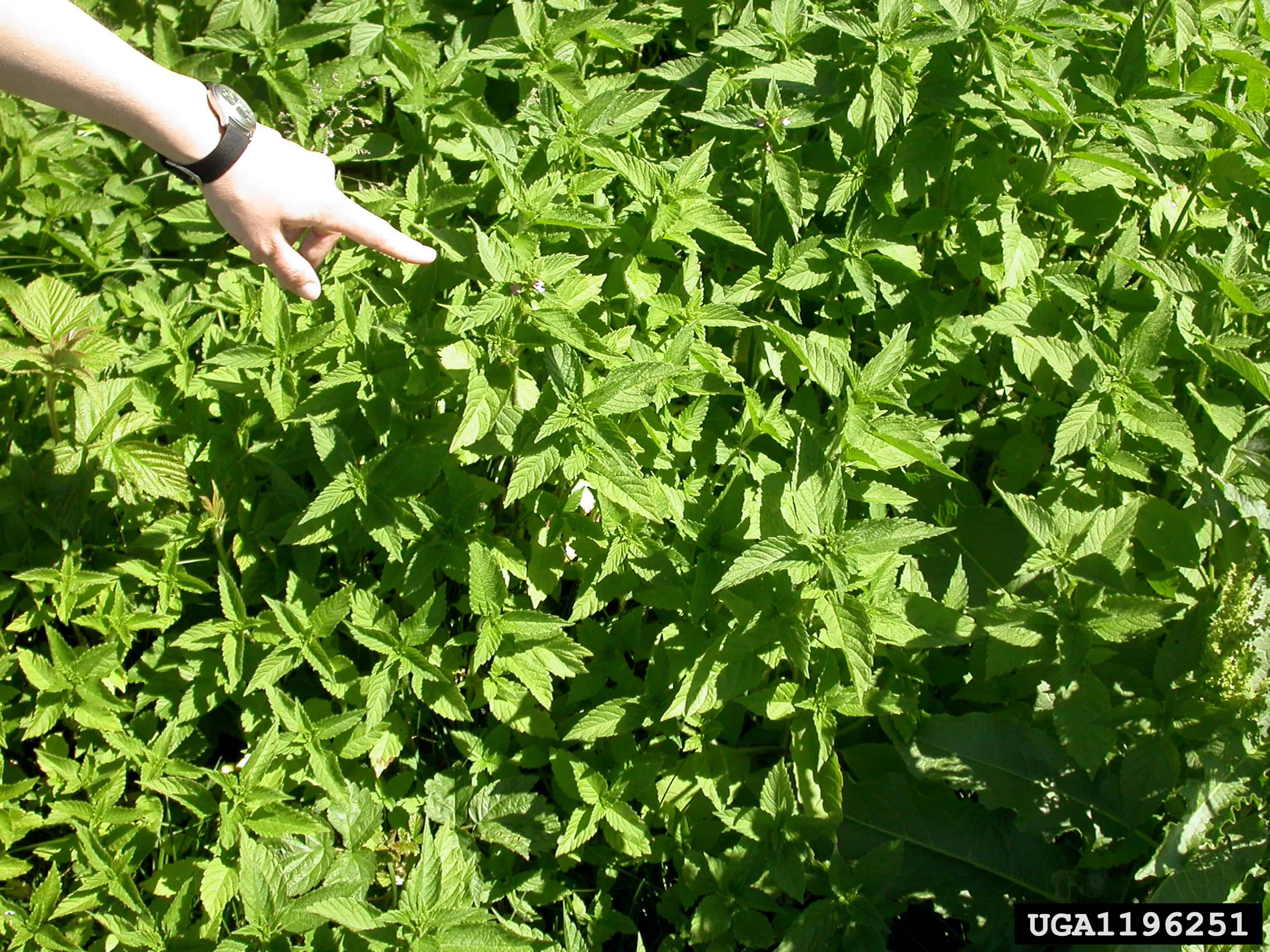
Galeopsis tetrahit infestation (Michael Shephard, USDA Forest Service, Bugwood.org)
Identification
Identification
-
Nutlet
Size
- Nutlet length*: 2.2 – 2.7 mm; width: 2.8 – 3.2 mm
*Note: minimum and maximum of 20 seeds in a normal range of this species using image measurement (ISMA 2020)
Additional size from literature:
• Nutlet length: 3.0 mm; width: 2.3 mm; thickness: 1.6 mm (O’Donovon and Sharma 1987)Shape
- Nutlet is broadly egg-shaped, compressed
- Lens-shaped or slightly trigonous near the point of attachment in 3D
- Immature nutlets are teardrop shaped, abruptly narrowed at the point of attachment
Surface Texture
- Nutlet surface smooth or pitted with sparse or dense bubbled patches
- Immature nutlets are smooth with small, scattered patches of bubbled texture
Colour
- Nutlet colour is generally dull or shiny brown with sparse dark brown mottles
- The raised, bubbled patches are light brown or whitish brown coloured
- Immature nutlets are dull brownish-orange coloured
Other Features
Point of attachment
- Point of attachment at the narrow end of nutlet,
- Point of attachment concave, circular or oval shape, dull brown coloured
- A short ridge extends from the point of attachment on one side of the nutlet, giving a slight trigonous shape.

Hemp-nettle (Galeopsis tetrahit) nutlets

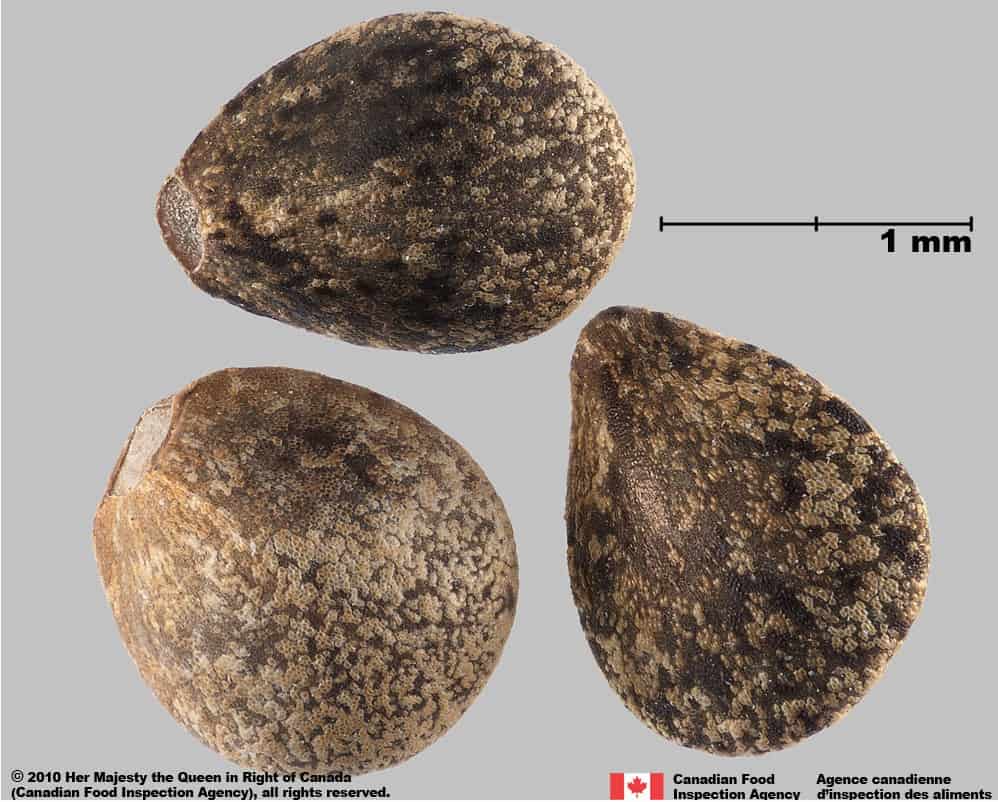
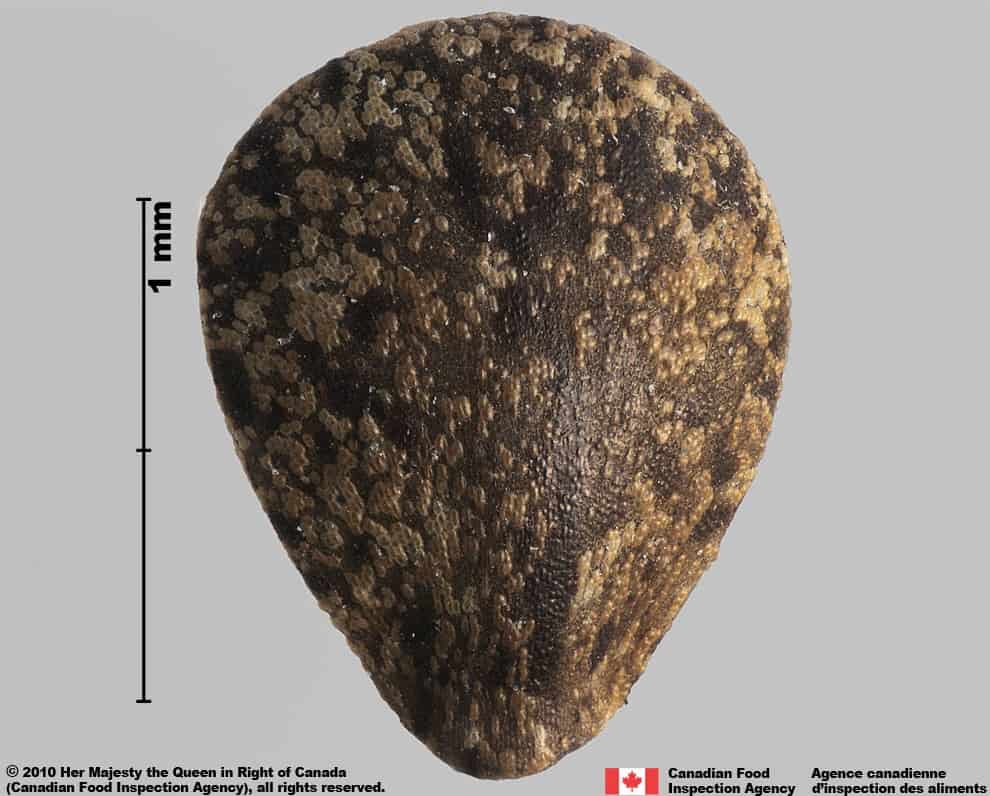
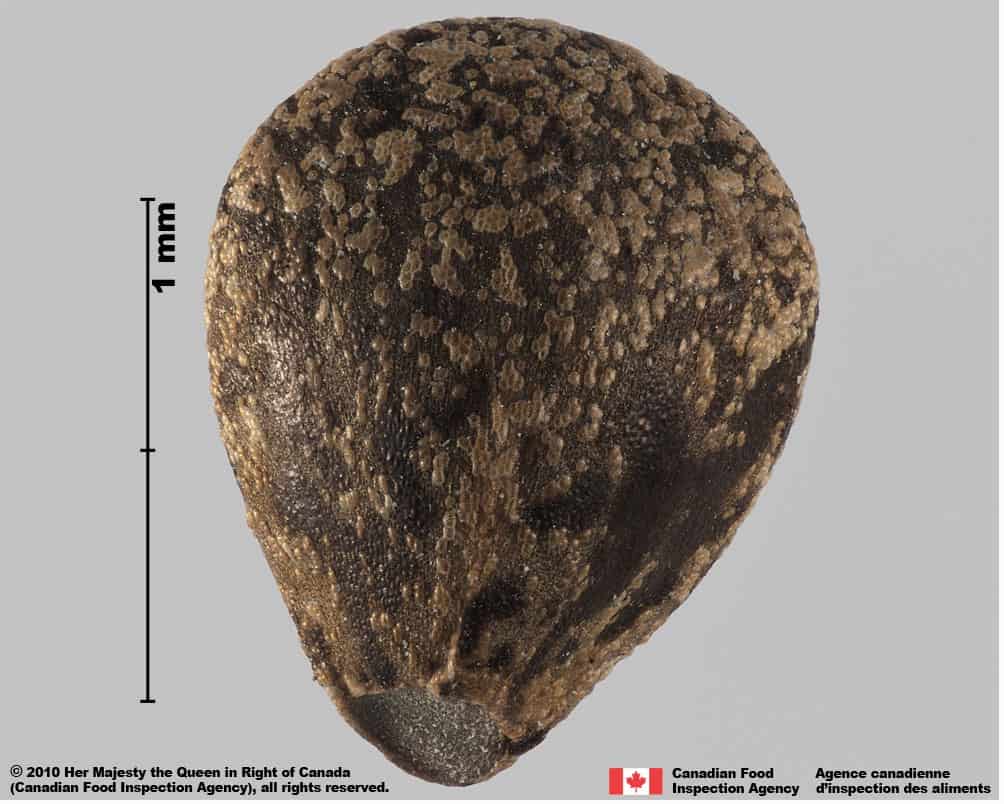
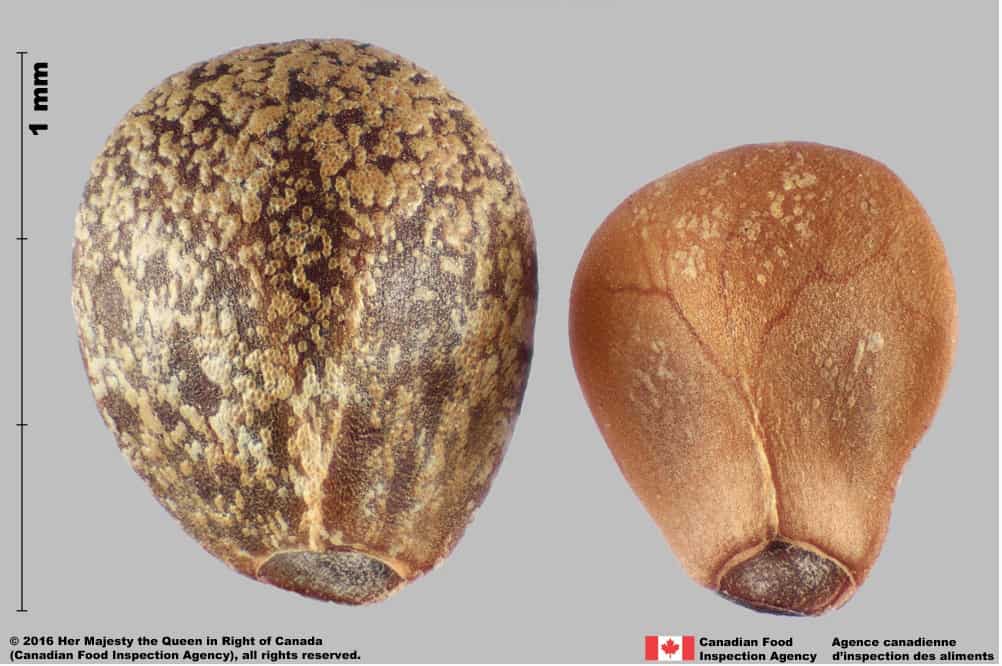
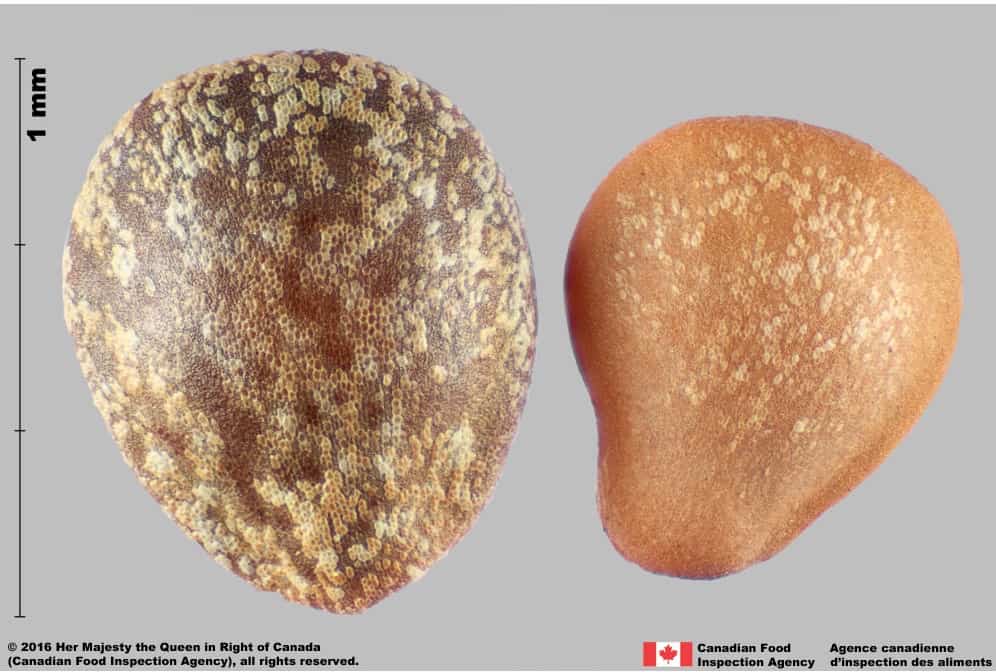
-
Seed
Size
- Seed size is similar to nutlet size
Shape
- Seed is egg-shaped with a pointed end
Surface Texture
- Surface is ridged reticulate with small interspaces, looks pitted
Colour
- Shiny orange coloured
Other Features
Hilum and hilum area
- Hilum is on one side of the seed near the pointed end
- Hilum is teardrop-shaped and black coloured
Other than hilum
- Seed coat is membranous and attached to the inside of the nutlet
-
Embryo
Size
- Embryo partially fills the seed
Shape
- Embryo spatulate shaped(Martin 1946)
Endosperm
- Endosperm is oily and translucent orange coloured
Other Features
- Embryo is in an axial position (Martin 1946)
Identification Tips
CONSEILS POUR L’IDENTIFICATION
The nutlets of Galeopsis do not have the strong trigonous shape or white tissue at the attachment point like other Lamiaceae species and are egg-shaped, appear biconvex in edge view, have a concave attachment point and raised patches of bubbled texture.
Most Galeopsis nutlets have similar surface features and variable colour patterns, and it is difficult to reliably distinguish between the species. The size, shape, colour of the nutlet and distribution of the species also need to be considered.

Hemp-nettle (Galeopsis tetrahit) nutlet






Additional Botany Information
AUTRES RENSEIGNEMENTS BOTANIQUES
Flowers/Inflorescence
- Flowers in dense clusters associated with upper stem leaves (O’Donovon and Sharma 1987)
- Flowers are 15-23 mm long, purple, white, or a mix of both colours (O’Donovon and Sharma 1987)
- Each flower produces four nutlets that remain in the 1 cm long calyx (O’Donovon and Sharma 1987)
- Calyx lobes are long spine-tipped, a distinguishing feature of the Galeopsis genus (Gill 1983; O’Donovon and Sharma 1987)
Vegetative Features
- Plant is 30-75 cm tall, with stems distinctly thicker under the opposite pairs of leaves (O’Donovon and Sharma 1987)
- Thicker stems below the leaves, flower clusters associated with upper leaves, and spine-tipped calyx lobes could be features for plant identification (Gill 1983; O’Donovon and Sharma 1987).
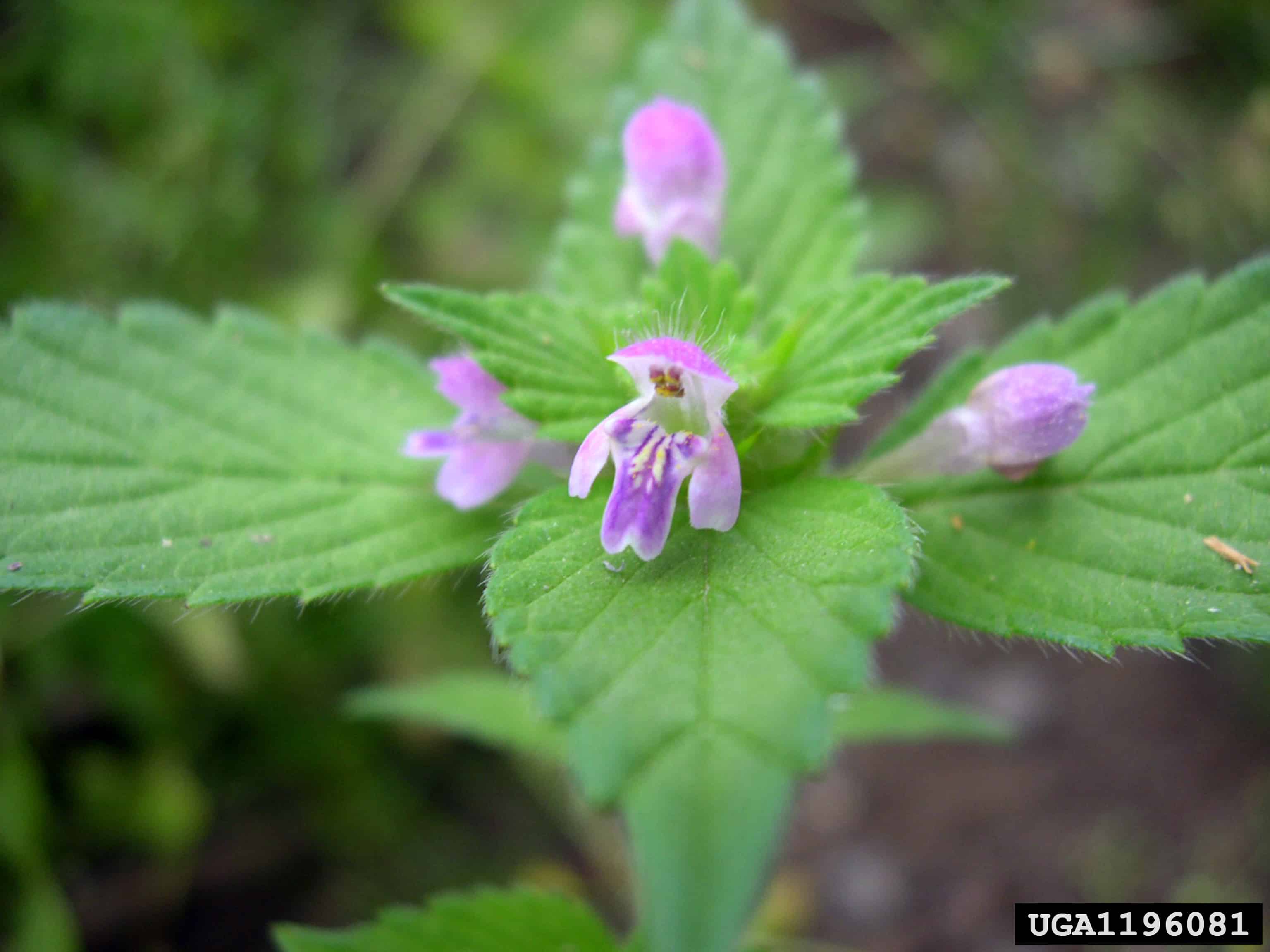
Galeopsis tetrahit flowers (Tom Heutte, USDA Forest Service, Bugwood.org)

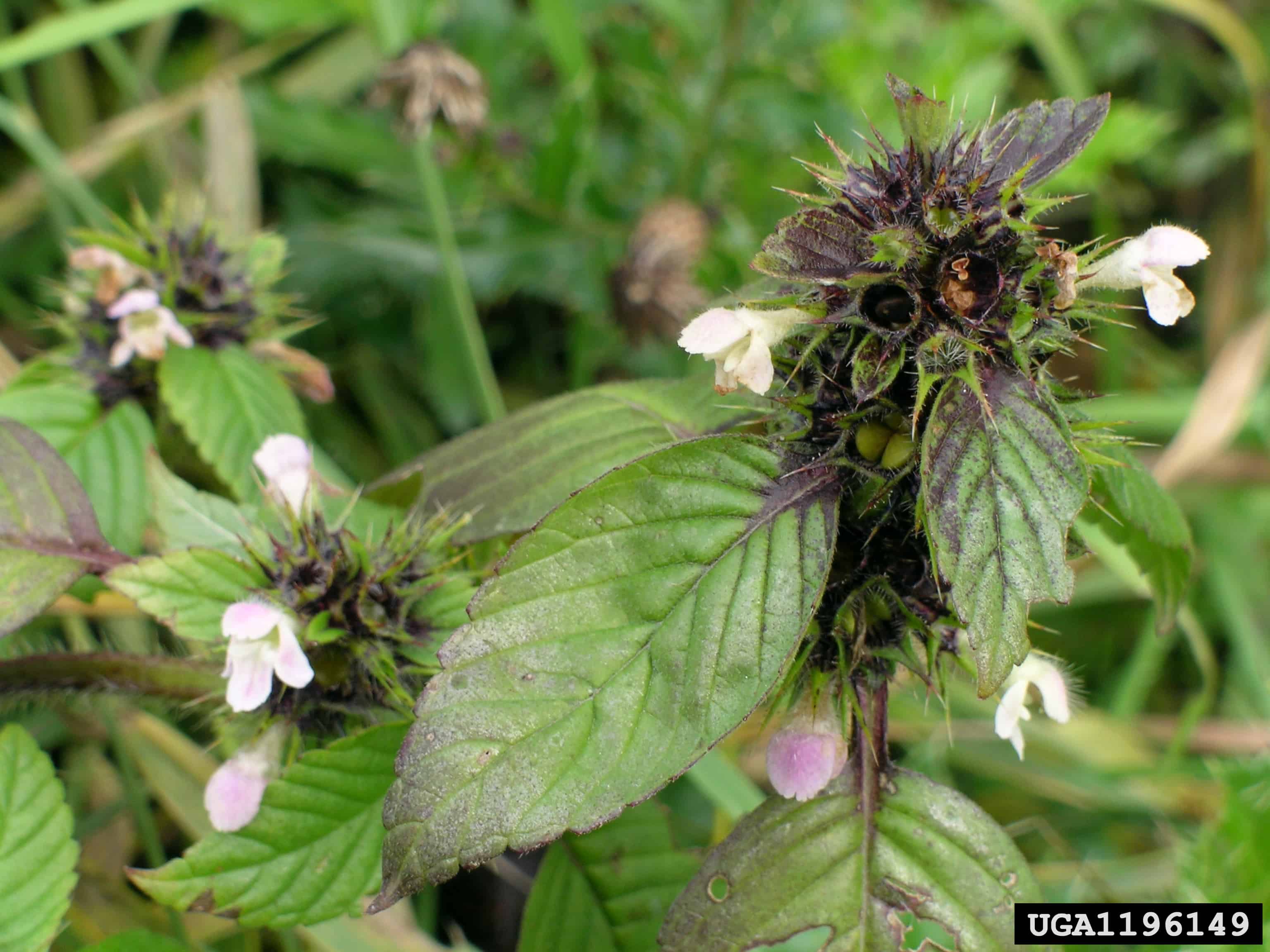
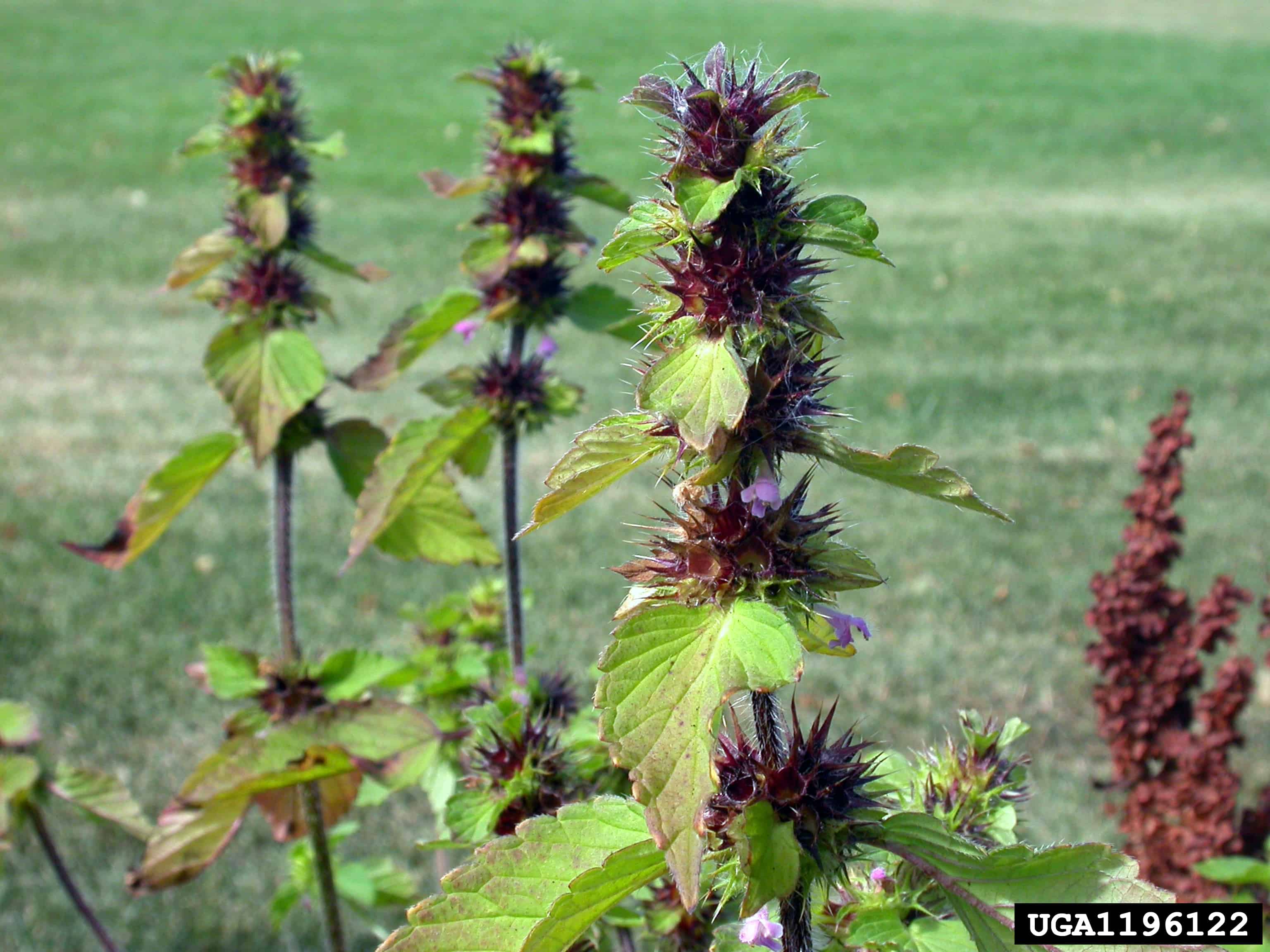
Similar Species
ESPÈCES SEMBLABLES
Similar species are based on a study of seed morphology of various species, and those with similar dispersal units are identified. The study is limited by physical specimen and literature availability at the time of examination, and possibly impacted by the subjectivity of the authors based on their knowledge and experience. Providing similar species information for seed identification is to make users aware of similarities that could possibly result in misidentification.
Galeopsis pubescens Besser
G. pubescens is an annual species with red, pink or purple flowers found in middle, eastern, and southern Europe (USDA-ARS 2022). The species has not been recorded in the United States and Canada (Brouillet et al 2010+; USDA-NCRS 2022). The nutlets are generally more narrow egg-shaped (length*: 2.1 – 2.7mm; width: 1.7 – 2.3 mm), and have a dark brown background colour compared to the lighter brown of G. tetrahit nutlets.
Galeopsis speciosa Mill.
G. speciosa is an annual species found across Europe (USDA-ARS 2022), and has also been recorded in Alberta, Ontario, and Quebec in Canada, but not in the United States to date (Brouillet et al 2010+; USDA-NCRS 2022). The nutlets are generally larger (length*: 2.5 – 3.2 mm; width: 1.9 – 2.5 mm) and have a dark brown background colour compared to the smaller size and lighter brown colour of G. tetrahit nutlets.
Galeopsis ladanum L.
This annual species originated in Europe and temperate Asia (USDA-ARS 2022). This species has spread to the northeastern United States and Colorado State, and Manitoba, Quebec and New Brunswick in Canada (Brouillet et al 2010+; USDA-NCRS 2022). The nutlets are narrow egg-shaped with a longer central ridge and light brown attachment point compared to G. tetrahit nutlets.
*Note: minimum and maximum of 20 seeds in a normal range of this species using image measurement (ISMA 2020)
Click to select species
Cliquez pour sélectionner les espèces
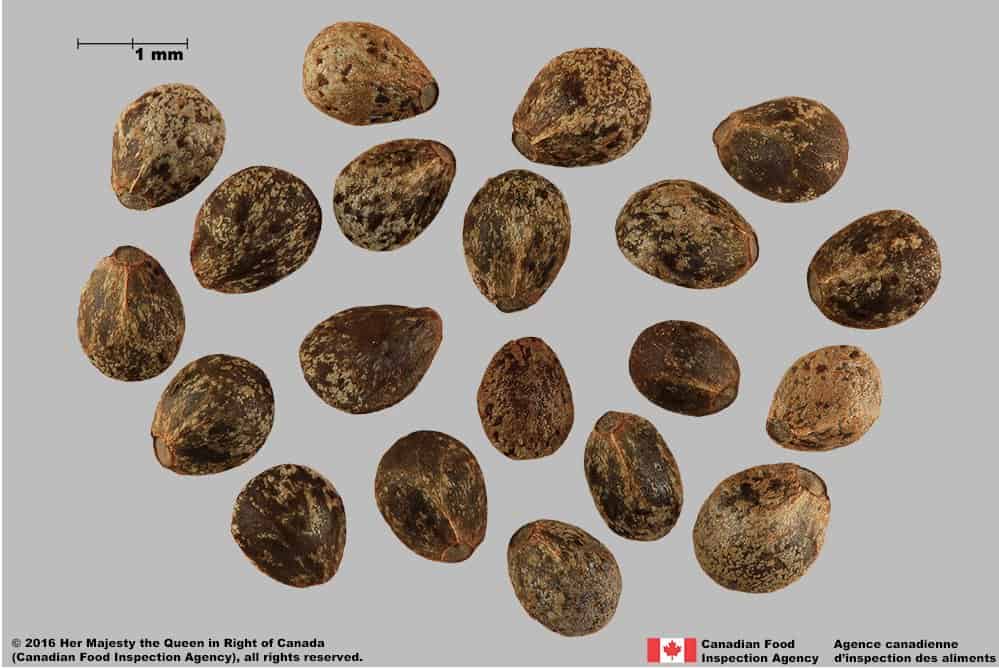
Galeopsis pubescens
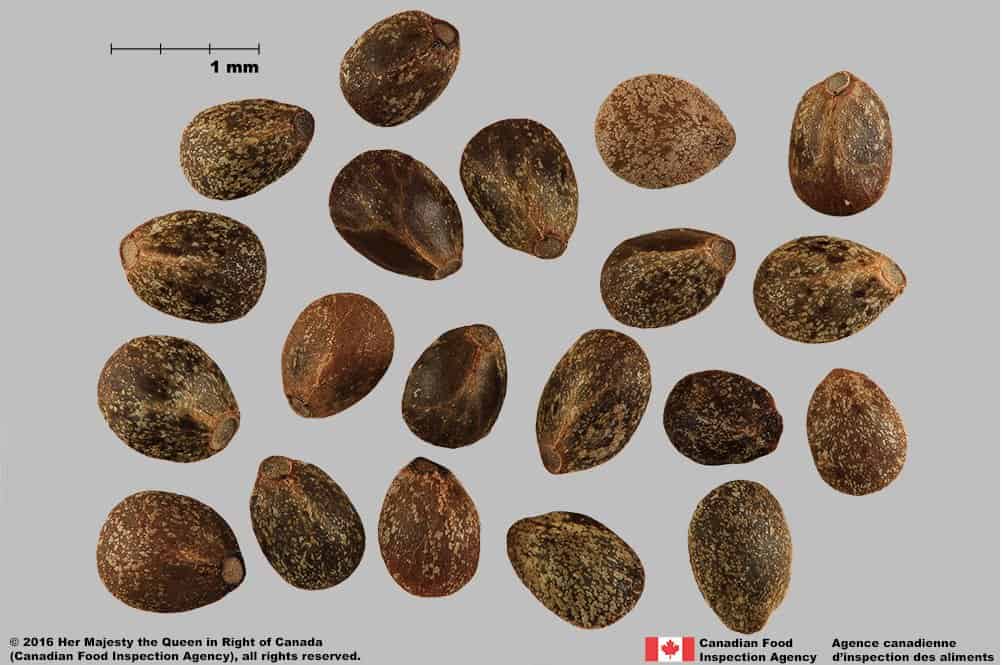
Galeopsis speciosa
Comparison Window
Fenêtre de comparaison
MAIN SPECIES
ESPÈCES PRINCIPALES
Galeopsis tetrahit

Galeopsis tetrahit
Lamiaceae
Hemp-nettle (Galeopsis tetrahit) nutlets
MAIN SPECIES
ESPÈCES PRINCIPALES
Galeopsis tetrahit

Galeopsis tetrahit
Lamiaceae
Hemp-nettle (Galeopsis tetrahit) nutlets
MAIN SPECIES
ESPÈCES PRINCIPALES
Galeopsis tetrahit

Galeopsis tetrahit
Lamiaceae
Hemp-nettle (Galeopsis tetrahit) nutlet
MAIN SPECIES
ESPÈCES PRINCIPALES
Galeopsis tetrahit

Galeopsis tetrahit
Lamiaceae
Hemp-nettle (Galeopsis tetrahit) nutlet
MAIN SPECIES
ESPÈCES PRINCIPALES
Galeopsis tetrahit

Galeopsis tetrahit
Lamiaceae
Hemp-nettle (Galeopsis tetrahit) nutlets; immature (R)
MAIN SPECIES
ESPÈCES PRINCIPALES
Galeopsis tetrahit

Galeopsis tetrahit
Lamiaceae
Hemp-nettle (Galeopsis tetrahit) nutlets; immature (R)
SIMILAR SPECIES
ESPÈCES SEMBLABLES
Galeopsis pubescens

Galeopsis pubescens
Lamiaceae
Hairy hemp-nettle (Galeopsis pubescens) nutlets
SIMILAR SPECIES
ESPÈCES SEMBLABLES
Galeopsis pubescens
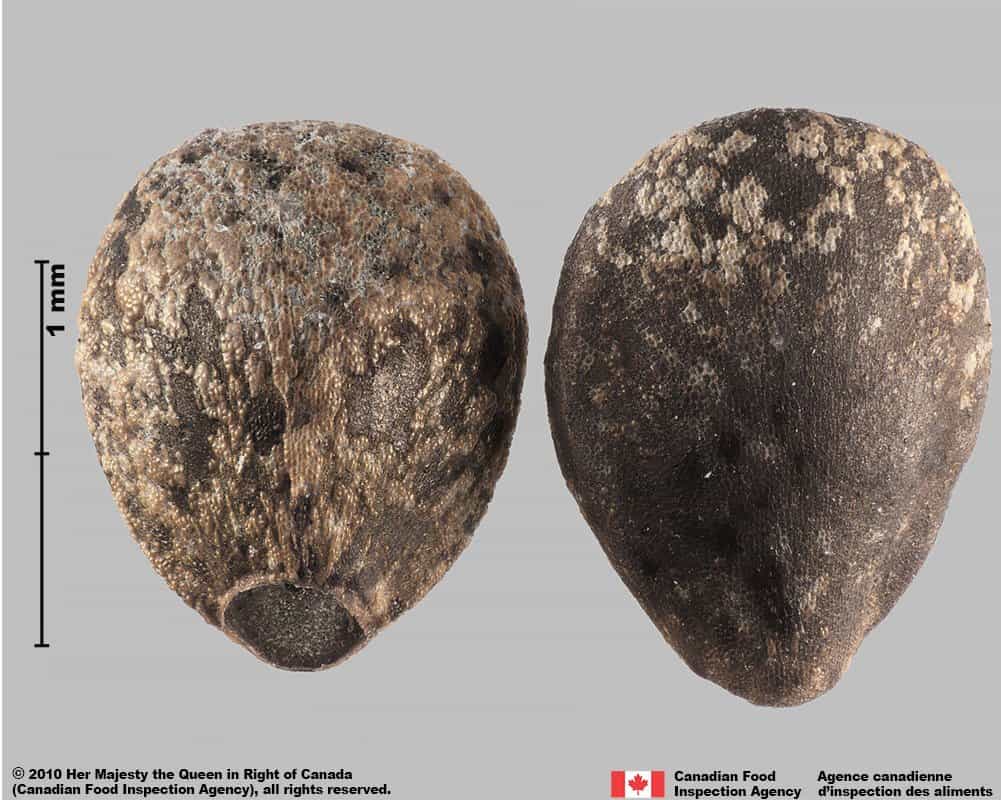
Galeopsis pubescens
Lamiaceae
Hairy hemp-nettle (Galeopsis pubescens) nutlets
SIMILAR SPECIES
ESPÈCES SEMBLABLES
Galeopsis pubescens
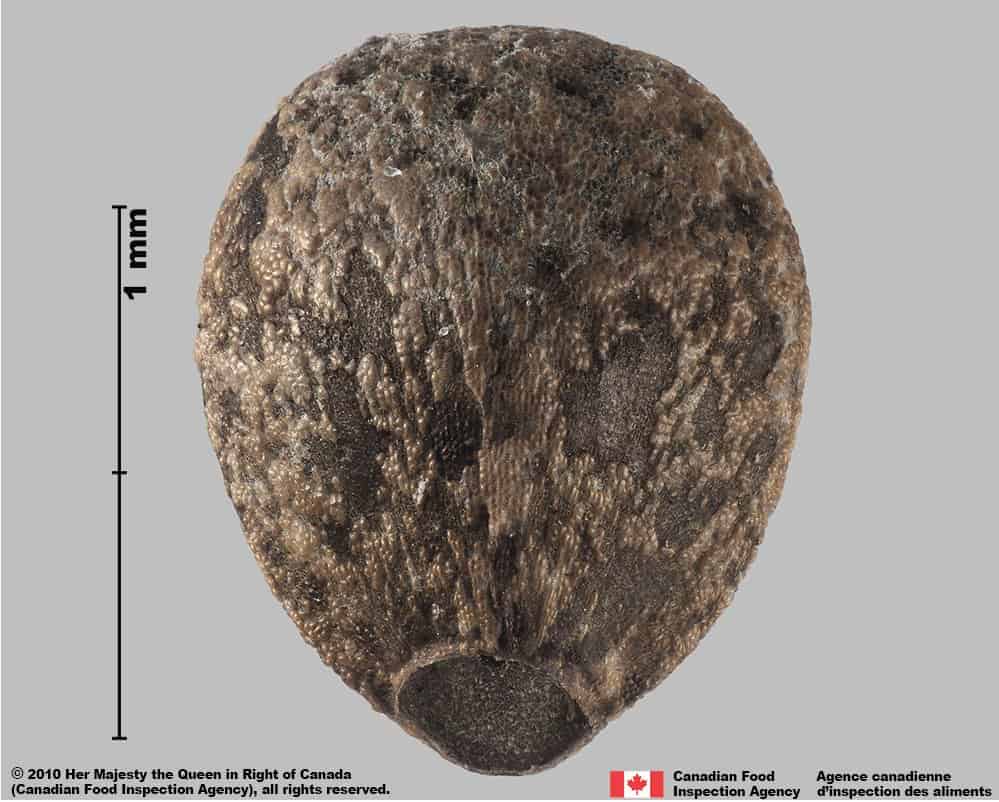
Galeopsis pubescens
Lamiaceae
Hairy hemp-nettle (Galeopsis pubescens) nutlet
Need ID Help?
Besoin d’aide pour l’identification?
Reference(s)
Référence(s)
Alex, J.F. 2011. Ontario weeds. Ontario Ministry of Agriculture Food and Rural Affairs, Guelph, Ontario, Canada. 304 pp.
Brouillet, L., Coursol, F., Meades, S. J., Favreau, M., Anions, M., Bélisle, P. and Desmet, P. 2010+. VASCAN, the database of vascular plants of Canada. http://data.canadensys.net/vascan/ Accessed July 21, 2022.
Conn J. S. and Werdin-Pfisterer N. R. 2010. Variation in Seed Viability and Dormancy of 17 Weed Species after 24.7 Years of Burial: The Concept of Buried Seed Safe Sites. Weed Science 58: 209–215
Darbyshire, S. J. 2003. Inventory of Canadian Agricultural Weeds. Agriculture and Agri-Food Canada, Research Branch. Ottawa, ON.
Gill, L.S. 1983. Cytotaxonomic Studies of the Tribe Stachydeae (Labiatae) in Canada. Willdenowia 13: 175-181
International Seed Morphology Association (ISMA). 2020. Method for Seed Size Measurement. Version 1.0. ISMA Publication Guide.
Klinkenberg, B. 2023. E-Flora BC: Electronic Atlas of the Plants of British Columbia: https://ibis.geog.ubc.ca/biodiversity/eflora/ Accessed August 16, 2023.
Légère, A. and Deschênes, J.M. 1989. Influence of time of emergence and plant density on growth of hemp-nettle (Galeopsis tetrahit). Canadian Journal of Plant Science 69: 171-183.
Légère, A. and Deschênes, J.M. 1991. Yield responses of oats and alfalfa to common hemp-nettle (Galeopsis tetrahit) interference. Canadian Journal of Plant Science 141-147.
Martin, A.C. 1946. The comparative internal morphology of seeds. The American Midland Naturalist 36: 513-660.
Maslova, E.V. 2008. Differentiation of two hemp nettle species (Galeopsis bifida Boenn. and G. tetrahit L.) inferred from morphological characters and DNA markers. Russian Journal of Genetics 44: 312–319.
O’Donovan, J.T. and Sharma, M.P. 1987. The biology of Canadian weeds. 78. Galeopsis tetahit L. Canadian Journal of Plant Science 67: 787-796.
United States Department of Agriculture-Agricultural Research Services (USDA-ARS). 2022. Germplasm Resources Information Network (GRIN), https://npgsweb.ars-grin.gov/gringlobal/taxon/taxonomysearch Accessed July 21, 2022.
United States Department of Agriculture-Natural Resources Conservation Service (USDA-NRCS). 2022. The PLANTS Database. National Plant Data Team, Greensboro, NC USA. https://plants.usda.gov/home Accessed July 26, 2022.



